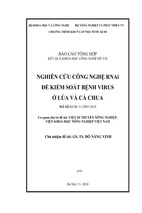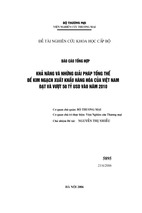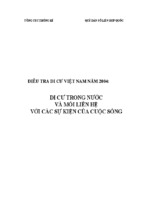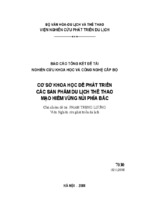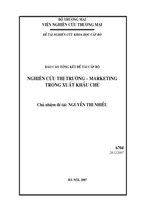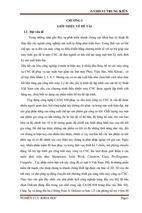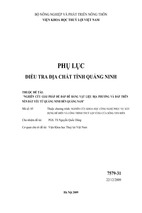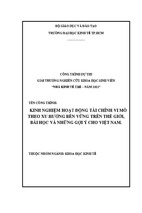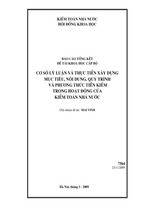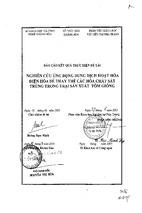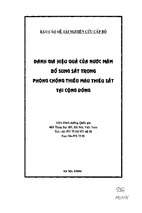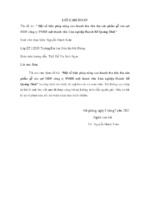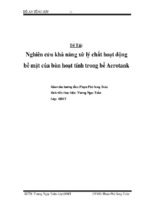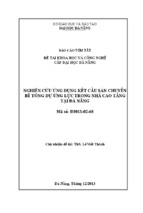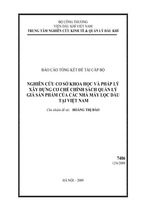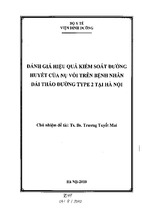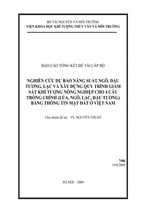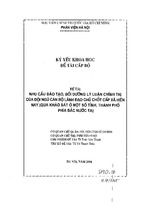VIETNAM ACADEMY OF SCIENCE AND TECHNOLOGY
INSTITUTE OF MATHEMATICS
TRẦN NHÂN TÂM QUYỀN
Convergence Rates for the Tikhonov
Regularization of Coefficient
Identification Problems in Elliptic Equations
Dissertation submitted in partial fulfillment
of the requirements for the degree of
DOCTOR OF PHILOSOPHY IN MATHEMATICS
Hanoi–2012
VIETNAM ACADEMY OF SCIENCE AND TECHNOLOGY
INSTITUTE OF MATHEMATICS
TRẦN NHÂN TÂM QUYỀN
Convergence Rates for the Tikhonov
Regularization of Coefficient
Identification Problems in Elliptic Equations
Speciality: Differential and Integral Equations
Speciality Code: 62 46 01 05
Dissertation Submitted in Partial
Fulfillment of the Requirements for the Degree of
DOCTOR OF PHILOSOPHY IN MATHEMATICS
Supervisor: Prof. Dr. habil. ĐINH NHO HÀO
Hanoi–2012
VIỆN KHOA HỌC VÀ CÔNG NGHỆ VIỆT NAM
VIỆN TOÁN HỌC
TRẦN NHÂN TÂM QUYỀN
TỐC ĐỘ HỘI TỤ CỦA PHƯƠNG PHÁP CHỈNH
TIKHONOV CHO CÁC BÀI TOÁN XÁC
ĐỊNH HỆ SỐ TRONG PHƯƠNG TRÌNH ELLIPTIC
Chuyên ngành: Phương trình vi phân và tích phân
Mã số: 62 46 01 05
Dự thảo
LUẬN ÁN TIẾN SĨ
Người hướng dẫn khoa học:
GS. TSKH. Đinh Nho Hào
Hà Nội–2012
Acknowledgements
I cannot find words sufficient to express my gratitude to my advisor, Profesor Đinh Nho
Hào, who gave me the opportunity to work in the field of inverse and ill-posed problems.
Furthermore, throughout the years that I have studied at the Institute of Mathematics,
Vietnam Academy of Science and Technology he has introduced me to exciting mathematical problems and stimulating topics within mathematics. This dissertation would never
have been completed without his guidance and endless support.
I would like to thank Professors Hà Tiến Ngoạn, Nguyễn Minh Trí and Nguyễn Đông
Yên for their careful reading of the manuscript of my dissertation and for their constructive
comments and valuable suggestions.
I would like to thank the Institute of Mathematics for providing me with such excellent
working conditions for my research.
I am deeply indebted to the leaders of The University of Danang, Danang University of
Education and Department of Mathematics as well as to my colleagues, who have provided
encouragement and financial support throughout my PhD studies.
Last but not least, I wish to express my endless gratitude to my parents and also to
my brothers and sisters for their unconditional and unlimited love and support since I was
born. My special gratitude goes to my wife for her love and encouragement. I dedicate this
work as a spiritual gift to my children.
Hà Nội, July 25, 2012
Trần Nhân Tâm Quyền.
Declaration
This work has been completed at Institute of Mathematics, Vietnam Academy of Science and Technology under the supervision of Prof. Dr. habil. Đinh Nho Hào. I declare
hereby that the results presented in it are new and have never been published elsewhere.
Author: Trần Nhân Tâm Quyền
Convergence Rates for the Tikhonov Regularization of
Coefficient Identification Problems in Elliptic Equations
By
TRẦN NHÂN TÂM QUYỀN
Abstract
Let Ω be an open bounded connected domain in Rd , d ≥ 1, with the Lipschitz boundary
∂Ω, f ∈ L2 (Ω) and g ∈ L2 (∂Ω) be given. In this work we investigate convergence rates for
the Tikhonov regularization of the ill-posed nonlinear inverse problems of identifying the
diffusion coefficient q in the Neumann problem for the elliptic equation
−div(q∇u) = f in Ω,
∂u
q
= g on ∂Ω,
∂n
and the reaction coefficient a in the Neumann problem for the elliptic equation
−∆u + au = f in Ω,
∂u
= g on ∂Ω,
∂n
from imprecise values z δ ∈ H 1 (Ω) of the exact solution u with ∥u − z δ ∥H 1 (Ω) ≤ δ. The
Tikhonov regularization is applied to convex energy functionals to stabilize these ill-posed
nonlinear problems. Under weak source conditions without the smallness requirements on
the source functions, we obtain convergence rates of the method.
Tốc độ hội tụ của phương pháp chỉnh Tikhonov cho
các bài toán xác định hệ số trong phương trình elliptic
Tác giả
TRẦN NHÂN TÂM QUYỀN
Tóm tắt
Giả sử Ω là một miền liên thông, mở và bị chặn trong Rd , d ≥ 1, với biên Lipschitz ∂Ω
và các hàm f ∈ L2 (Ω), g ∈ L2 (∂Ω) cho trước. Luận án nghiên cứu các bài toán ngược phi
tuyến đặt không chỉnh xác định hệ số truyền tải q trong bài toán Neumann cho phương
trình elliptic
−div(q∇u) = f trong Ω,
∂u
q
= g trên ∂Ω
∂n
và hệ số phản ứng a trong bài toán Neumann cho phương trình elliptic
−∆u + au = f trong Ω,
∂u
= g trên ∂Ω
∂n
khi nghiệm chính xác u được cho không chính xác bởi dữ kiện đo đạc z δ ∈ H 1 (Ω) với
∥u − z δ ∥H 1 (Ω) ≤ δ. Phương pháp chỉnh Tikhonov cho hai bài toán trên được áp dụng cho
các phiến hàm năng lượng lồi. Với điều kiện nguồn yếu không đòi hỏi tính đủ nhỏ của các
hàm nguồn, ta thu được các đánh giá về tốc độ hội tụ của phương pháp chỉnh Tikhonov.
Contents
Introduction
5
0.1
Modelling . . . . . . . . . . . . . . . . . . . . . . . . . . . . . . . . . . . .
5
0.2
Inverse problems and ill-posedness . . . . . . . . . . . . . . . . . . . . . . .
6
0.2.1. Inverse problems . . . . . . . . . . . . . . . . . . . . . . . . . . . .
6
0.2.2. Ill-posedness . . . . . . . . . . . . . . . . . . . . . . . . . . . . . . .
8
Review of Methods . . . . . . . . . . . . . . . . . . . . . . . . . . . . . . .
10
0.3.1. Integrating along characteristics . . . . . . . . . . . . . . . . . . . .
11
0.3.2. Finite difference scheme . . . . . . . . . . . . . . . . . . . . . . . .
12
0.3.3. Output least-squares minimization . . . . . . . . . . . . . . . . . .
13
0.3.4. Equation error method . . . . . . . . . . . . . . . . . . . . . . . . .
14
0.3.5. Modified equation error and least-squares method . . . . . . . . . .
15
0.3.6. Variational approach . . . . . . . . . . . . . . . . . . . . . . . . . .
16
0.3.7. Singular perturbation . . . . . . . . . . . . . . . . . . . . . . . . . .
18
0.3.8. Long-time behavior of an associated dynamical system . . . . . . .
19
0.3.9. Regularization . . . . . . . . . . . . . . . . . . . . . . . . . . . . . .
20
Summary of the Dissertation . . . . . . . . . . . . . . . . . . . . . . . . . .
23
0.3
0.4
1 Problem setting and auxiliary results
1.1
1.2
28
Diffusion coefficient identification problem . . . . . . . . . . . . . . . . . .
28
1.1.1. Problem setting . . . . . . . . . . . . . . . . . . . . . . . . . . . . .
28
1.1.2. Differentiability of the coefficient-to-solution operator . . . . . . . .
29
1.1.3. Some preliminary results . . . . . . . . . . . . . . . . . . . . . . . .
31
Reaction coefficient identification problem . . . . . . . . . . . . . . . . . .
35
1.2.1. Problem setting . . . . . . . . . . . . . . . . . . . . . . . . . . . . .
35
1.2.2. Differentiability of the coefficient-to-solution operator . . . . . . . .
36
1.2.3. Some preliminary results . . . . . . . . . . . . . . . . . . . . . . . .
37
2 L2 -regularization
42
1
2
Convergence rates for L2 -regularization of the diffusion coefficient identification problem . . . . . . . . . . . . . . . . . . . . . . . . . . . . . . . . .
42
2.1.1. L2 -regularization . . . . . . . . . . . . . . . . . . . . . . . . . . . .
42
2.1.2. Convergence rates . . . . . . . . . . . . . . . . . . . . . . . . . . . .
46
2.1.3. Discussion of the source condition . . . . . . . . . . . . . . . . . . .
51
Convergence rates for L2 -regularization of the reaction coefficient identification problem . . . . . . . . . . . . . . . . . . . . . . . . . . . . . . . . . . .
55
2.2.1. L2 -regularization . . . . . . . . . . . . . . . . . . . . . . . . . . . .
55
2.2.2. Convergence rates . . . . . . . . . . . . . . . . . . . . . . . . . . . .
59
2.2.3. Discussion of the source condition . . . . . . . . . . . . . . . . . . .
62
Conclusions . . . . . . . . . . . . . . . . . . . . . . . . . . . . . . . . . . . . . .
63
2.1
2.2
3 Total variation regularization
3.1
64
Convergence rates for total variation regularization of the diffusion coefficient identification problem . . . . . . . . . . . . . . . . . . . . . . . . . .
64
3.1.1. Regularization by the total variation . . . . . . . . . . . . . . . . .
64
3.1.2. Convergence rates . . . . . . . . . . . . . . . . . . . . . . . . . . . .
71
3.1.3. Discussion of the source condition . . . . . . . . . . . . . . . . . . .
75
Convergence rates for total variation regularization of the reaction coefficient
identification problem . . . . . . . . . . . . . . . . . . . . . . . . . . . . . .
78
3.2.1. Regularization by the total variation . . . . . . . . . . . . . . . . .
78
3.2.2. Convergence rates . . . . . . . . . . . . . . . . . . . . . . . . . . . .
84
3.2.3. Discussion of the source condition . . . . . . . . . . . . . . . . . . .
87
Conclusions . . . . . . . . . . . . . . . . . . . . . . . . . . . . . . . . . . . . . .
89
3.2
4 Regularization of total variation combining with L2 -stabilization
4.1
4.2
90
Convergence rates for total variation regularization combining with L2 stabilization of the diffusion coefficient identification problem . . . . . . . .
90
4.1.1. Regularization by total variation combining with L2 -stabilization
.
90
4.1.2. Convergence rates . . . . . . . . . . . . . . . . . . . . . . . . . . . .
97
4.1.3. Discussion of the source condition . . . . . . . . . . . . . . . . . . .
99
Convergence rates for total variation regularization combining with L2 stabilization of the reaction coefficient identification problem . . . . . . . . 101
4.2.1. Regularization by the total variation combining with L2 -stabilization 101
4.2.2. Convergence rates . . . . . . . . . . . . . . . . . . . . . . . . . . . . 105
4.2.3. Discussion of the source condition . . . . . . . . . . . . . . . . . . . 108
Conclusions . . . . . . . . . . . . . . . . . . . . . . . . . . . . . . . . . . . . . . 110
3
General Conclusions
111
List of the author’s publications related to the dissertation
113
Bibliography
115
4
Function Spaces
Rd
Ω
C k (Ω)
C ∞ (Ω)
Cck (Ω)
Lp (Ω)
W k,p (Ω)
W0k,p (Ω)
H k (Ω), H0k (Ω)
H −k (Ω)
BV (Ω)
The d-dimensional Euclidean space
Open, bounded set with the Lipschitz boundary in Rd
The set of k times continuously differential functions on Ω, 1 ≤ k ≤ ∞
The set of infinitely differential functions on Ω
The set of functions in C k (Ω) with compact support in Ω, 1 ≤ k ≤ ∞
The Lebesgue space on Ω, 1 ≤ p ≤ ∞
The Sobolev space of functions with k-th order weak derivatives in Lp (Ω)
Closure of Cc∞ (Ω) in W k,p (Ω)
Abbreviations for the Hilbert spaces W k,2 (Ω), W0k,2 (Ω)
Dual space of H0k (Ω)
Space of functions with bounded total variation on Ω, pp. 22
Notation
|x|ℓp
∥u∥X
X∗
⟨u∗ , u⟩(X ∗ ,X)
⟨u, v⟩H
L(X, Y )
T∗
∇v
∆v
divΥ
∂R(q)
ξ
DR
(p, q)
∫
|∇v|
Ω
u
zδ
Q, A, Qad , Aad
q, q, a, a
CΩ , α, β, Λα , Λβ
U (q), U (a)
Jzδ (q), Gzδ (a)
ρ
q ∗ , a∗
q † , a†
qρδ , aδρ
X
XBV (Ω)
XL∞ (Ω)
H⋄1 (Ω)
ℓp -norm of x ∈ Rd , 1 ≤ p ≤ ∞
Norm of u in the normed space X
Dual space of the normed space X
Duality product u∗ (u) of u ∈ X and u∗ ∈ X ∗
Inner product of u, v in the Hilbert space H
Space of bounded linear operators between normed spaces X and Y
Adjoint in L(Y ∗ , X ∗ ) of T ∈ L(X, Y )
Gradient of the scalar function v
The Laplacian of the scalar function v
Divergence of the vector-valued function Υ
Subdifferential of the proper convex functional R at q ∈ DomR, pp. 21
The Bregman distance with respect to R and ξ of two elements p, q, pp. 21
Total variation of the scalar function v, pp. 22 or seminorm in W 1,1 (Ω)
Exact data, pp. 28, 29, 36
Observed data, pp. 28, 29, 36
Admissible sets of coefficients, 29, 35, 64, 78, 90, 101
Positive constants, pp. 29, 35
Positive constants, pp. 29, 36
Coefficient-to-solution operators, pp. 29, 36
Energy functionals, pp. 29, 36
Regularization parameter, pp. 42, 55, 64, 78, 90, 101
A-priori estimates of the true coefficients, pp. 42, 55
q ∗ -, a∗ -solutions of the inverse problems, pp. 42, 56, 66, 80, 91, 101
Regularized solutions, pp. 43, 56, 66, 79, 91, 101
The space L∞ (Ω) ∩ BV (Ω) with the norm ∥q∥L∞ (Ω) + ∥q∥BV (Ω) , pp. 66
The space X with respect to the BV (Ω)-norm, pp. 67
The space X with respect to the L∞ (Ω)-norm, pp. 67
Space of functions in H 1 (Ω) with mean-zero, pp. 28
Introduction
The problem of identifying parameters in distributed parameter systems arising in
groundwater hydrology, heat conduction, population models, seismic exploration and reservoir simulation attracted great attention from many scientists in the last 50 years or so.
For surveys on the subject, we refer the reader to [4, 14, 19, 33, 34, 35, 37, 38, 40, 45, 46,
47, 49, 55, 58, 59, 60, 62, 61, 64, 68, 72, 76, 77, 89, 90, 91, 92, 95, 96, 97, 98, 105, 106, 110,
112, 113, 118, 119, 123, 126, 127, 128, 129, 130] and the references therein. The term “distributed parameter systems” means that the mathematical models in these situations are
governed by partial differential equations. In this thesis we are interesting in the problem
of identifying coefficients in groundwater hydrology, whose mathematical models contain
function-coefficients which describe physical properties of the fluid flows or of the porous
media. The identified coefficients appeared in the governing equations are not directly
measurable from the physical point of view and have to be determined from historical
observations. Such problems are called inverse problems which are in general very difficult
to solve because of the nonuniqueness and instability (the ill-posedness) of the identified
coefficients. The aim of this thesis is to study convergence rates for the Tikhonov regularization of these ill-posed nonlinear problems. Before presenting our results, to ease of
reading we shortly describe the mathematical models on fluid flows and porous media.
0.1
Modelling
The governing equation of coefficients in an unsteady fluid flow can be represented by
(see, for example, [14, 112])
∂u
− div(q(x)∇u) + a(x)u = f (x, t), x ∈ Ω ⊂ Rd , t > 0
∂t
accompanied by the initial and boundary conditions
s(t)
u(x, 0) = u0 (x), x ∈ Ω,
u(x, t) = g1 (x, t), x ∈ Γ1 , t > 0,
= g2 (x, t), x ∈ Γ2 , t > 0,
q(x) ∂u(x,t)
∂n
where
Ω
∂Ω
x
t
u(x, t)
flow region,
boundary of the flow region,
∂Ω = Γ1 ∪ Γ2 , interior(Γ1 ) ∩ interior(Γ2 ) = ∅,
space variable,
time variable,
head,
5
(0.1)
(0.2)
6
q(x)
a(x)
s(t)
f (x, t)
u0 (x), g1 (x, t), g2 (x, t)
n = n(x)
∂
∂n
∂
∂t
diffusion coefficient,
reaction coefficient,
storage coefficient,
source-sink term,
specified functions,
unit outer normal at x ∈ ∂Ω,
normal derivative,
time derivative.
In the three-dimensional space the hydraulic head u at point (x, y, z) of the flow region Ω
is defined by
p
u = u(x, y, z) =
+ z,
ρg
where p = p(x, y, z) is fluid pressure, ρ = ρ(x, y, z) is density of the fluid and g is acceleration of gravity.
The steady case of (0.1)–(0.2) is
−div(q(x)∇u) + a(x)u = f (x), x ∈ Ω ⊂ Rd , d ≥ 1
(0.3)
accompanied by the boundary condition
u(x) = g1 (x), x ∈ Γ1 ,
= g2 (x), x ∈ Γ2 .
q(x) ∂u(x)
∂n
(0.4)
Physically, u can be interpreted as the piezometrical head of the ground water in Ω, the
function f characterizes the sources and sinks in Ω and the function g2 characterizes the
inflow and outflow through Γ2 (see, for example [124]). We say that this boundary value
problem is of the mixed type, if neither Γ1 nor Γ2 is empty, of the Dirichlet type if Γ2 = ∅,
and of the Neumann type if Γ1 = ∅.
0.2
0.2.1.
Inverse problems and ill-posedness
Inverse problems
The steady system (0.3)–(0.4) contains three known functions f , g1 and g2 . When the
coefficients q and a are given, the problem of uniquely solving u from the partial differential
equation (0.3)–(0.4) is called the forward problem. Conversely, the problem of identifying
the coefficients q and a from observed data of a solution u of (0.3)–(0.4) is called the inverse
problem.
In this work we are working with the inverse problems for the steady cases of (0.1)–(0.2).
Namely, we are concerned with the Neumann problem for (0.3). We investigate convergence
rates for the Tikhonov regularization of the problems of identifying the coefficient q in the
Neumann problem for the elliptic equation
−div(q∇u) = f in Ω,
∂u
q
= g on ∂Ω
∂n
(0.5)
(0.6)
7
and the coefficient a in the Neumann problem for the elliptic equation
−∆u + au = f in Ω,
∂u
= g on ∂Ω
∂n
(0.7)
(0.8)
from imprecise values z δ ∈ H 1 (Ω) of a solution u with
∥u − z δ ∥H 1 (Ω) ≤ δ,
(0.9)
δ > 0 being given, while f and g are prescribed. The problem of simultaneously estimating
the coefficients q and a in (0.3) with either the Neumann, or the Dirichlet or mixed boundary condition has been studied in [15, 62, 64, 83, 84, 86, 87]. The functionals q and a in
these problems are called the diffusion (or filtration or transmissivity, or conductivity) and
reaction coefficients, respectively. For different kinds of the porous media, the diffusion
coefficient varies in a large scale (see, for example, [123])
Gravels
Sands
Silts
Clays
Limestone
0.1 to 1 cm/sec
10−3 to 10−2 cm/sec
10−5 to 10−4 cm/sec
10−9 to 10−7 cm/sec
10−4 to 10−2 cm/sec.
These problems are mathematical models in different topics of applied sciences, e.g.,
from aquifer analysis. The coefficient identification problems in groundwater (or oil or
other fluids) modeling have a history older than a half century, although we may encounter
the first publication on hydraulic well with J. Dupuit in the year 1863. In 1950s and 1960s,
analytical solutions were presented to identify the hydraulic conductivity and the storage
coefficient around a well through fitting equipotential lines to aquifer testing data. In 1970s,
numerical solutions were used to identify hydraulic coefficients by optimization of a “norm”
in the state space. During the last four decades many techniques have been developed for
solving inverse problems of parameter identification in distributed parameter systems such
as hydraulic parameters, boundary conditions, pollution sources, dispersivities, adsorption
kinetics, and filtration and reaction coefficients.
In 1973, Neuman [103] classed the techniques for solving inverse problems of identifying
coefficients in distributed parameter systems into either “direct” or “indirect”. In the “direct method” the head variations and derivatives are assumed to be known or are estimated
over the entire flow region and the original governing equations are transformed into linear
first–order partial differential equations of the hyperbolic type for the unknown coefficients.
With the combined knowledge of the heads and initial and boundary conditions, a direct
solutions for the unknown coefficients may be possible. However, in practice, there is only
a limited number of observations being available which are sparsely distributed in the flow
region. The interpolation is then used to extend these data across the spatial domain,
this process may contain serious errors that would cause errors in the results of identified
coefficients. The output least-squares techniques have been used to the so–called “indirect
methods”, which try to minimize a “norm” in the state space of the difference between
observed and calculated heads at specified observation points. The main advantage of the
output least-squares methods are that the formulation of the inverse problem is applicable
to the situation where the number of observations is limited and it does not require the
derivatives of the measured data. However, these methods are several shortcomings. First,
the object functional to be minimized is nonlinear and nonconvex. Second, the numerical
8
implementation is often iterative that in order to obtain useful results a large number of
repeated solution of the forward problem is required. Further, since the minimization being
nonlinear and nonconvex, the third major shortcoming of these methods is that the critical dependence on the initial guesses of identified coefficients for rapid convergence of the
iterative procedures. With large, poorly–conditioned functionals, the convergence may be
slow, pick out only a local minimum, or even fail (see also [14, 45, 96, 113, 118, 127, 129]).
One of the aims of this thesis is to overcome these serious shortcoming of the output leastsquares method. We will use the energy functionals which are convex, rather than the
output least-squares (see more details in § 0.4).
0.2.2.
Ill-posedness
Suppose that the coefficient q in (0.5)–(0.6) is given so that we can determine the
unique solution u and thus define a nonlinear coefficient-to-solution operator which maps
from q to the solution u = u(q) := U (q). Thus, the inverse problem in our setting is to
solve the equation
U (q) = u
for q with u being given, which is the nonlinear and ill-posed inverse problem.
In 1923, Hadamard [57] introduced the notion of well-posedness. A problem is said to
be well posed if the following conditions are satisfied
1. Existence: There is a solution of the problem.
2. Uniqueness: There is at most one solution of the problem.
3. Stability: The solution continuously depends on the data (in some appropriate
topologies).
If at least one of the above conditions is not satisfied, the problem is said to be ill-posed
(or improperly posed). He thought that such problems have no physical meaning. However,
many important problems in practice and science are ill-posed (see [13, 26, 68, 112, 123]),
in which the instability always causes serious problems. If a problem lacks the stability,
a small error in observed data may lead to significant errors in the solution, that makes
numerical solution extremely difficult.
Now we illustrate the ill-posedness of the problem of identifying the coefficient a in
(0.7)–(0.8) from u by an example given by Baumeister and Kunisch [15]. Let
a(x) = 2, u(x) = 1
and
an (x) =
2 − cos(n + 1)x
1
, un (x) =
cos(n + 1)x + 1, n ∈ N.
1
(n + 1)2
1 + (n+1)2 cos(n + 1)x
Then, for all n ∈ N,
and
−u′′ + au = −u′′n + an un in (0, π)
u′ (0) = u′n (0), u′ (π) = u′n (π).
One verifies that for all n ∈ N,
∥un − u∥H 1 (0,π)
√
2π
≤
,
n+1
9
√
while
∥an − a∥L2 (0,π) ≥
π
, ∀n ∈ N.
2
Thus, the identification problem a in (0.7)–(0.8) is ill-posed in the L2 (0, π) and L∞ (0, π)norms.
If we rewrite equation (0.5) as a first-order hyperbolic partial differential equation in
the unknown q, which leads to
∇q · ∇u + q∆u = −f.
It turns out that if ∇u vanishes in subregions of Ω then it is impossible to determine q on
the these subregions. This is one of the reasons why our coefficient identification problem
is ill-posed (see, for example, [109]). This situation is possible when f ̸= 0, although
Alessandrini [5] has shown that if f = 0 and if u|∂Ω has a finite number of relative maxima
and minima then ∇u only vanishes at a finite number of points in Ω, with finite multiplicity.
We note that in our setting we assume to have observations of z δ ∈ L2 (Ω), ∇z δ ∈
(L2 (Ω))d for the solution u and its gradient, respectively. Such assumptions have been
used by many authors, e.g., Acar [1], Banks and Kunisch [13], Chan and Tai [24, 25],
Chavent [26], Chavent and Kunisch [29], Chen and Zou [31], Ito and Kunisch [70, 71], Ito,
Kroller and Kunisch [69], Keung and Zou [79], Knowles et al [84]–[86], Kohn and Lowe [88],
Vainikko [121, 122], Vainikko and Kunisch [124], Zou [131]. In practice, the observation
is measured at certain points and we need to interpolate the point observations to get
distributed observations. The gradient may not be measurable directly, but there are
several ways to approximate it. For example, Chan and Tai [24, 25] suggested to use
the differentiation formulas by Anderssen and Hegland [8], Knowles et al [86] applied first
a mollification process and then finite differences, whereas Kaltenbacher and Schröberl
[73] used a Clément operator Πsm for smoothing the data and obtained the gradient as
a by-product (see also [32, pp. 154–157]). Kaltenbacher and Schröberl [73, pp. 679–680]
showed that if ∥u − z δ ∥L2 (Ω) ≤ ϵ and u ∈ H 2 (Ω) ∩ W 1,∞ (Ω), then one can explicitly choose
√
smoothing parameters such that ∥u − Πsm z δ ∥L2 (Ω) ≤ cϵ and ∥u − Πsm z δ ∥H 1 (Ω) ≤ c ϵ
with c being the norm of Πsm from L2 (Ω) to L2 (Ω). The question is if u and ∇u are
given, whether our inverse problem is ill-posed? The case a is sought, the above explicit
example by Baumeister and Kunisch [15] showed this fact in the L2 and L∞ norms. We
could not find an explicit example showing that the problem of identifying q from the
observations of u and ∇u is ill-posed in the same topologies. However, the ill-posedness of
this problem was discussed by Kohn and Lowe [88, p. 123]. Furthermore, Vainikko [122]
showed that this problem is ill-posed, even if |∇u| ≥ c > 0 in Ω. Concerning this fact, see
also the dissertation of Cherlenyak [32, pp. 147–154] where he gave a full proof of this fact
along some private communications with Vainikko. Besides, Chavent and Kunisch [29, pp.
432–434] (see also [26, p. 28 and §4.9]) have also shown the ill-posedness of the problem.
However, under certain additional assumption, the problem of identifying q in (0.5)–(0.6) is
well-posed in the H −1 -norm as measurement error in the H 1 -norm, where H −1 is the dual
of H 1 (see also [85]). In fact, assume that the boundary ∂Ω is of class C 1 and u ∈ W 2,∞ (Ω)
with |∇u| ≥ γ a.e. on Ω, where γ is a positive constant. Then, we can verify that if v is a
solution of
∇ · (q∇u) = ∇ · (p∇v) in Ω,
∂v
∂u
=p
on ∂Ω,
q
∂n
∂n
(0.10)
(0.11)
10
then
∥q − p∥H −1 (Ω) ≤ C∥u − v∥H 1 (Ω) .
(0.12)
In fact, first we note for each element ξ ∈ H 1 (Ω), there exists ϑξ ∈ H 1 (Ω) satisfying
∇u · ∇ϑξ = ξ
(0.13)
(see Lemma 2.1.10 below). Further, there exists a positive constant C independent of ξ
such that
∥ϑξ ∥H 1 (Ω) ≤ C∥ξ∥H 1 (Ω) .
(0.14)
Since v solves (0.10)–(0.11), we have
∫
∫
q∇u∇ϑξ =
p∇v∇ϑξ .
Ω
Then,
Ω
∫
∫
p∇(v − u)∇ϑξ .
(q − p)∇u∇ϑξ =
Ω
Ω
By (0.13)–(0.14), we conclude that
�∫
� �∫
�
�
� �
�
� (q − p)ξ � = � p∇(v − u)∇ϑξ �
�
� �
�
Ω
Ω
≤ ∥p∥L∞ (Ω) ∥∇(u − v)∥L2 (Ω) ∥∇ϑξ ∥L2 (Ω)
≤ C∥u − v∥H 1 (Ω) ∥ϑξ ∥H 1 (Ω)
≤ C∥u − v∥H 1 (Ω) ∥ξ∥H 1 (Ω)
for all ξ ∈ H 1 (Ω), where the positive constant C is independent of ξ. This leads to
estimate (0.12). However, the well-posedness of the identification problem in this way is
not practicable since a good approximation in the H −1 -norm is physically useless. For the
identification problem, it is interesting in special identification methods that are well-posed
in the Lp -norm, 1 ≤ p ≤ ∞.
Up to now, there have been many papers published devoted to the coefficient identification problems considered in this thesis. Different techniques and methods have been
proposed for solving them such as output least squares methods [6, 26, 27, 29, 30, 36, 37,
46, 53, 99, 100], regularization methods [42, 54, 62, 60, 61, 59, 91, 102, 104, 116, 120], equation error methods [51, 76, 78], variational methods [88], integrating along characteristics
[109], finite difference schemes [110], singular perturbation technique [5], the augmented
Lagrangian technique [31, 52, 69, 70, 72], the long-time behavior of an associated dynamical
system [65], the level set method [25, 114, 115], and iterative methods [11, 12, 20, 74, 75, 80].
In the next section we will describe with more details of these approaches to our inverse
problems.
0.3
Review of Methods
We now discuss some of the techniques and methods that have been used for solving
coefficient identification problems. Compared to the problem of identifying q in (0.5), the
problem of identifying a in (0.7) has received less attention. However, there are some
authors studied the problem such as Alt [6], Banks and Kunisch [13], Baumeister and
11
Kunisch [14], Chavent [26], Chavent, Kunisch and Roberts [30], Colonius and Kunisch
[36, 37], Engl, Hanke and Neubauer [41], Engl, Kunisch and Neubauer [42], Hào and
Quyen [59, 60, 61, 62], Hein and Meyer [64], Ito, Kroller and Kunisch [69], Ito and Kunisch
[70, 72], Knowles [82, 83, 84], Neubauer [101], and Resmerita and Scherzer [108]. Thus,
in the following we will describe some approaches introduced in [5, 42, 46, 65, 76, 88, 105,
108, 109, 110] for solving the coefficient identification problem q in (0.5).
0.3.1.
Integrating along characteristics
In the article [109] Richter has written equation (0.5) as a first-order hyperbolic partial
differential equation in the unknown q = q(x), which leads to
L(q, u) := ∇q(x) · ∇u(x) + q(x)∆u(x) = −f (x), x ∈ Ω ⊂ R2 .
(0.15)
He assumes that
(H1 ) u ∈ C 2 (Ω), f ∈ L∞ (Ω).
(H2 )
inf max{|∇u|, ∆u} > 0.
Ω
(0.16)
This condition is equivalent to the one that the domain Ω can be divided into subregions
Ω1 and Ω2 in which |∇u| and ∆u are uniformly positive, respectively
Ω = Ω 1 ∪ Ω2 ,
|∇u| ≥ k1 > 0 in Ω1 ,
∆u ≥ k2 > 0 in Ω2 .
(0.17)
(H3 ) A“solution” to equation (0.15) means a function q ∈ L∞ (Ω) which is continuous and differentiable along the characteristic curves of (0.15) and it holds the ordinary
differential equation to which (0.15) reduces along such curves.
Then, the author concluded that for any f , the equation L(q, u) = −f has a unique
solution q = q(x) assuming prescribed values along the “inflow” boundary Γ ⊂ ∂Ω (essentially that portion of ∂Ω where the outer normal derivative of u is negative) and
(
{
}
)
∥f ∥L∞ (Ω)
[u]
∥q∥L∞ (Ω) ≤ C(u) max sup |q|,
+ 2 ∥f ∥L∞ (Ω) ,
k2
k1
Γ
where
[u] = sup u − inf u,
Ω
Ω
{
(
)}
ξ[u]
C(u) = max 1, exp
,
k1
{
}
∆u
ξ = sup −
.
|∇u|
Ω1
Now, suppose that L(p; v) = −g, where p is the diffusion coefficient produced by a perturbed solution v ≈ u and forcing function g ≈ f . Since
L(q − p; u) = −L(p; v − u) + (f − g),
12
we obtain the following continuous dependence
(
{
∥q − p∥L∞ (Ω)
b
C
≤ C(u) max sup |q − p|,
k2
Γ
}
)
[u] b
+ 2C ,
k1
where
b = ∥∇p∥L∞ (Ω) ∥∇(u − v)∥L∞ (Ω) + ∥p∥L∞ (Ω) ∥∆(u − v)∥L∞ (Ω) + ∥f − g∥L∞ (Ω) .
C
0.3.2.
Finite difference scheme
The author in the article [110] investigates a finite difference method for identifying of
the coefficient in equation (0.5) under condition (0.17) as long as q(x) is prescribed along
the inflow portion of the boundary ∂Ω of Ω. For this scheme, equation (0.5) is viewed as a
first order hyperbolic partial differential equation in the unknown q(x), which reduces to
(0.15). First we describe the numerical method in [110] on the unit square (0, 1) × (0, 1).
We define a uniform grid as follows
(xi , yj ) = (ih, jh), 0 ≤ i, j ≤ n + 1, h =
1
.
n+1
Denote by Ωh the set of interior grid points
Ωh = {(xi , yj ) | 1 ≤ i, j ≤ n}
and Γh the discrete inflow boundary (a grid point in ∂Ω is in Γh if its nearest neighboring
grid point in Ωh has a higher u value; e.g., (xi , y0 ) ∈ Γh for i ∈ {1, 2, ..., n} if u(xi , y1 ) >
u(xi , y0 )). The grid values of q(x, y), u(x, y) and f (x, y) will be denoted by qij , uij and fij ,
respectively.
Equation (0.15) is discretized as
Lh (qij , uij ) = −fij , 1 ≤ i, j ≤ n
(0.18)
with
qij − qkj uij − ukj qij − qil uij − uil
·
+
·
+ qij Huij ,
h
h
h
h
ui+1,j + ui−1,j + ui,j+1 + ui,j−1 − 4uij
Huij =
,
h2
Lh (qij , uij ) =
where
k is the first index of the minimum of {ui−1,j , uij , ui+1,j } and l is the second index
of the minimum of {ui,j−1 , uij , ui,j+1 }.
Solving the equation Lh (qij , uij ) = −fij for qij , we have
(
)
( u −u )
u −u
qkj ij h kj + qil ij h il − hfij
qij =
.
uij −ukj
uij −uil
+
+
hHu
ij
h
h
Under the assumption (0.16), Richter has showed that the discrete problem (0.18) has a
unique solution qij assuming prescribed values on Γh . Further, if u and q are sufficiently
regular in Ω, u ∈ C 3 (Ω) and q ∈ C 2 (Ω), then
max
0≤i,j≤n+1
|qij − q(xi , yj )| = O(h) as h → 0
13
assuming qij = q(xi , yj ) on Γh . Finally, Richter has extended the applicability of this
difference scheme to irregular domains and to problems in which the condition (0.16) does
not hold but ∇u and ∆u do not simultaneously vanish anywhere in Ω.
0.3.3.
Output least-squares minimization
It seems that Frind and Pinder [48] were the first people who applied the output leastsquares method to solve the problem of identifying the coefficient q(x) in the Neumann
problem for the elliptic equation (0.5)–(0.6). The least-squares approach says that if u(p)
is the solution of (0.5)–(0.6), where the coefficient q is replaced with p, then p is a good
approximation of q if the difference of a measurement z of u and u(p) is small in L2 (Ω). For
practical purposes, we need to define finite dimensional spaces to implement this approach.
Let {∆h }0 0 such that ∇u · ⃗ν ≥ σ for
all x ∈ Ω.
{
}
∂u
(H2 ) u ∈ W r+3,∞ (Ω) and Γ = x ∈ ∂Ω | ∂n
> 0 ∈ C r+2 with r ≥ 1.
(H3 ) q ∈ H r+1 (Ω) and 0 < q ≤ min q(x) ≤ max q(x) ≤ q. Further, Ah = Shr and
Ω
Vh =
Shr+1 ,
Ω
where
Shr = {v ∈ C(Ω) | v|T ∈ Pr , ∀T ∈ ∆h }
with Pr being the space of polynomials of degree less than or equal to r in the variables x1
and x2 .
(H4 ) The observation error is of the form
∥u − z∥L2 (Ω) ≤ ϵ.
14
Then, for all h sufficiently small, we have
∥q − qh ∥L2 (Ω) ≤ C(hr + h−2 ϵ),
where qh is any solution of problem (Ph ) and C is a positive constant independent of h and
ϵ. Therefore, if z is the continuous piecewise polynomial interpolation of degree r + 1 of u,
then
∥u − z∥L2 (Ω) = O(hr+2 ),
by the standard approximation result, and we have the estimate error
∥q − qh ∥L2 (Ω) = O(hr ).
0.3.4.
Equation error method
In this method we replace the exact solution u by the measurement data z in (0.5).
With z and f being given, we consider the mapping ψ(q) = ∇·(q∇z)+f and solve ψ(q) = 0
for the “true” coefficient q = q(x) by solving the problem
min ∥∇ · (q∇z) + f ∥2H ,
(0.19)
q∈Qad
where Qad is the admissible set of coefficients and H is an appropriately chosen Hilbert
space in which the boundary conditions on z can be incorporated into (0.19). Differently
from the output least-squares method, (0.19) is convex and hence the existence of a unique
global minimizer follows.
Under an identifiability assumption the equation error method is realized with H =
L (Ω). A multigrid algorithm is devised to solve the linear matrix equation which arises
from discretization of (0.19) and application of a necessary optimality condition.
2
An alternative approach can be based on the weak formulation of (0.19). In the case
of homogeneous Dirichlet boundary conditions z|∂Ω = 0, it is given by
min ∥∇ · (q∇z) + f ∥2H −1 (Ω) ,
(0.20)
q∈Qad
where H −1 (Ω) is the dual space of H01 (Ω). Note that (0.20) is equivalent to
min ∥∆−1 (∇ · (q∇z) + f )∥2H 1 (Ω) ,
q∈Qad
0
where ∆ denotes the Laplacian from H01 (Ω) to H −1 (Ω) with homogeneous Dirichlet boundary conditions. On the other hand, since
( ∫
)
∫
−1
2
− q∇z∇v + f v ,
∥∆ (∇ · (q∇z) + f )∥H 1 (Ω) = sup
0
v∈H01 (Ω)
Ω
Ω
it is evident that the data are only differentiated once in the weak formulation of the
equation error method (0.20) as opposed to two differentiations which are required in
(0.19) with H = L2 (Ω). The analogue of the weak formulation with the Dirichlet boundary
∂z
=
condition being replacing by the assumption of the availability of flux boundary data q ∂n
g on ∂Ω and its numerical treatment for smooth as well as for discontinuous coefficients q
is given in [1].
- Xem thêm -


